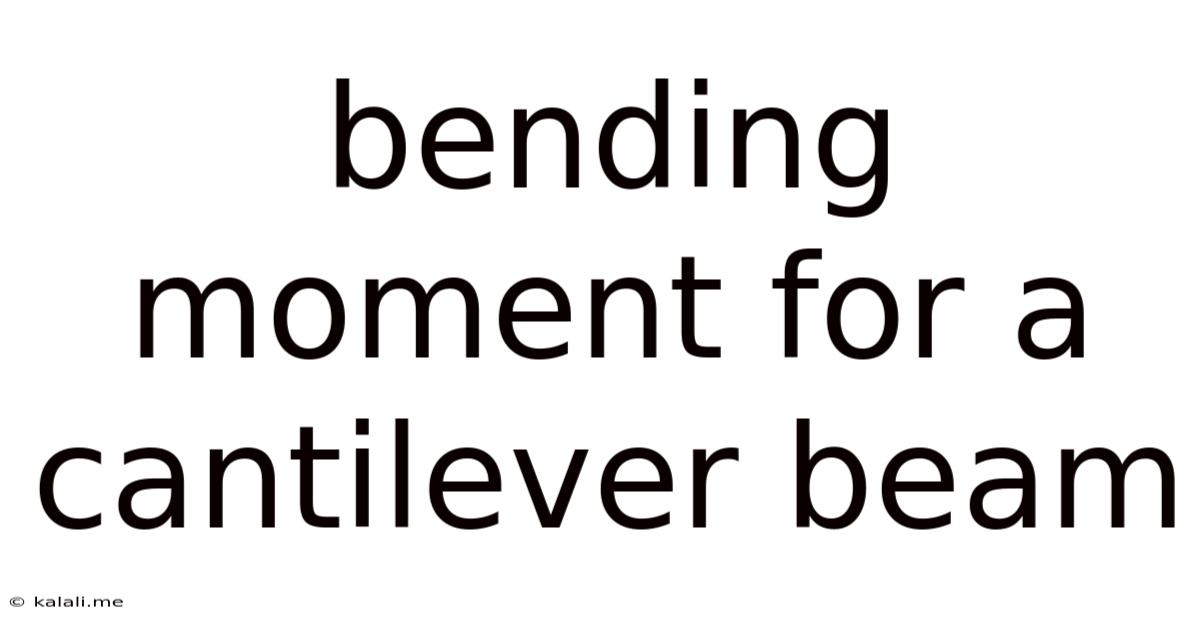Bending Moment For A Cantilever Beam
Kalali
Jun 11, 2025 · 3 min read

Table of Contents
Understanding Bending Moment in a Cantilever Beam
This article delves into the concept of bending moment, specifically focusing on cantilever beams. We'll explore what bending moment is, how to calculate it for different loading conditions, and the significance of understanding this crucial structural concept. A strong grasp of bending moment is essential for engineers and anyone involved in structural design and analysis.
What is Bending Moment?
Bending moment, often simply called moment, represents the internal resistance within a structural member like a beam to bending. Imagine a beam supporting a load; the load creates an internal stress within the beam, causing it to bend. The bending moment is the measure of this internal resistance to bending at any given point along the beam. It's measured in Newton-meters (Nm) or pound-feet (lb-ft) and is a crucial factor in determining the strength and safety of a structure. Understanding bending moment diagrams is key to assessing stress and deflection in beams.
Cantilever Beams: A Specific Case
A cantilever beam is a structural member fixed at one end and free at the other. This configuration leads to unique bending moment characteristics. Because it's fixed at one end, the cantilever beam experiences maximum bending moment at the fixed support. This is a critical point to consider when designing and analyzing these structures. The bending moment gradually decreases towards the free end, eventually reaching zero.
Calculating Bending Moment in Cantilever Beams
The calculation of bending moment depends heavily on the type of load applied to the cantilever beam. Here are some common scenarios:
1. Point Load at the Free End
This is the simplest scenario. A single concentrated load (P) at the free end produces a bending moment (M) at any point 'x' along the beam that's linearly proportional to the distance 'x' from the free end.
- Formula: M = P * x (where x is the distance from the free end)
- Maximum Bending Moment: At the fixed support (x = L, where L is the length of the beam), the maximum bending moment is M<sub>max</sub> = P * L
2. Uniformly Distributed Load (UDL)
A uniformly distributed load spreads evenly across the entire length of the beam. The calculation for bending moment becomes slightly more complex.
- Formula: M = (w * x²)/2 (where w is the load per unit length, and x is the distance from the free end)
- Maximum Bending Moment: At the fixed support (x = L), the maximum bending moment is M<sub>max</sub> = (w * L²)/2
3. Combination of Loads
Real-world scenarios often involve multiple loads acting simultaneously on a cantilever beam. In these cases, the principle of superposition applies. This means you can calculate the bending moment caused by each individual load separately and then sum the results to find the total bending moment at any point along the beam. Remember that the bending moment is a vector quantity and the direction must be considered.
Understanding Bending Moment Diagrams
Bending moment diagrams are graphical representations of the bending moment along the length of a beam. They are invaluable tools for structural analysis, clearly illustrating the magnitude and distribution of bending moment. The diagrams help engineers identify the location and magnitude of the maximum bending moment, crucial for determining the beam's required strength and material selection. Drawing accurate bending moment diagrams requires a systematic approach and understanding the load conditions.
Importance of Understanding Bending Moment
Accurate bending moment calculation is crucial for several reasons:
- Structural Design: Ensuring the beam can withstand the applied loads without failure.
- Material Selection: Choosing the appropriate material and cross-section to handle the maximum bending moment.
- Deflection Analysis: Predicting how much the beam will deflect under load. This is essential for ensuring functional performance and avoiding excessive deformation.
- Stress Calculation: Determining the internal stresses within the beam, allowing engineers to verify that the stresses remain within safe limits.
By understanding the principles of bending moment in cantilever beams, engineers can design safe and efficient structures capable of withstanding various loading conditions. Mastering bending moment calculations is an essential skill in structural engineering and related disciplines.
Latest Posts
Latest Posts
-
How Many Days Is 10 000 Hours
Jul 02, 2025
-
What Vehicle Does A Stp S6607 Oil Filter Fit
Jul 02, 2025
-
How Much Is A Quarter Of Million Dollars
Jul 02, 2025
-
How Many Liters Are In A Fifth
Jul 02, 2025
-
How Much Is 50 Gm Of Butter
Jul 02, 2025
Related Post
Thank you for visiting our website which covers about Bending Moment For A Cantilever Beam . We hope the information provided has been useful to you. Feel free to contact us if you have any questions or need further assistance. See you next time and don't miss to bookmark.